Journal of Ergonomics
Open Access
ISSN: 2165-7556
ISSN: 2165-7556
Research Article - (2020)Volume 10, Issue 2
This study explored the ergonomics associated with blasting activities at Majan Limestone quarry. The remoteness, altitude and severe weather conditions made blasting activities unwieldy, prompting the need for a leeway to augment the stress and discomfort associated with it. Consultations were made with the blasting crew with detailed explanations as regards the need for an ergonomic evaluation. A risk factor report card was created and issued out to the blasting crew. Manual tasks associated with blasting were observed, while work place records were reviewed. During the study, some ergonomic interventions were introduced to ameliorate the stress and reduce the exposure to risk factors; the improvements were noted with some recommendations. Other quarries or mines with similar working conditions may find the recommendations useful.
Ergonomics; Blasting; Risk factors; Majan mining; Limestone; Khareef; Oman
The productivity and profitability of a quarrying operation is underpinned by the precision of its blasting programme. How that program is implemented can determine how well operations run downstream. The terrain and usage of commercial explosives make limestone quarrying a hazardous venture, where most of the jobs involve arduous labour. A comfortable working environment using tools designed for specific jobs translates into a successful and event free blast. Stress and discomfort emanating from severe weather conditions occasioned by lack of appropriate Personal Protective Equipment (PPE) suitable for such weather will surely affect the blasting process.
Ergonomics is considered a multidisciplinary field of applied science where knowledge about human proficiencies, skills, limitations, and needs are taken into account when analysing the interactions among people, technology, and the work environment [1]. Blasting activities require that the crew perform motions repeatedly, often in harsh weather conditions. Awkward posturing, bending over (Figure 1), squatting, bending the wrist, pulling and lifting, sometimes involving having a tight grip on objects and lifting heavy materials are all encountered while blasting and these repeated motions can lead to injuries. Disorders due to repetitive motion affect the musculoskeletal system, which is made up of bones and soft tissues like muscles, tendons, ligaments, and cartilage [2]. The makeup of the musculoskeletal system is subject to injury from sprains, strains, fractures and dislocations [3]. By applying ergonomic principles at the quarry with a methodical process, risk factor exposures will be reduced or eliminated entirely.
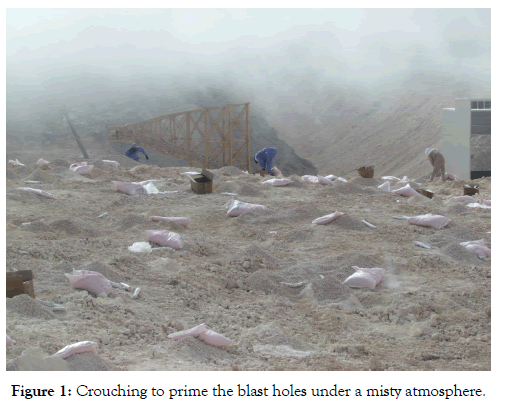
Figure 1: Crouching to prime the blast holes under a misty atmosphere.
Majan Mining Company is involved in the quarrying of Limestone in the Uyun Mountain range, west of Teetam, near Salalah in the Dhofar region of Southern Oman. The company produces crushed limestone in size range of 02-120 mm and also crushed ore below 2 mm. The quarry situated about 1250 m above sea level is divided into two sections; an older quarry with its pit in the west (Q1); and a newer quarry (Q2) northwards. The bench height is about 15 m while the haul roads, 14 m wide have a gradient of 10°.
Using the conventional method of drilling and blasting, the limestone is quarried for crushing. The company carries out drilling using its own surface crawler drill rigs while it employs the services of a specialist contractor, Detonator Blasting and Contracting Company LLC, to handle its blasting needs. Apart from the delivery of explosives, the contractor also provides full blasting services with its own personnel comprising of two to three mining engineers one of whom is the blaster in charge, and seven helpers. Majan mining company on the other hand provides about eight staff to aid in the blasting activities comprising a foreman and helpers, altogether they form an all-male blasting crew. Blasting is done twice a week, routinely starting as early as 6.30 am with a range of 190-400 holes per blast. The blasting activity normally lasts for about 4 hours.
Approach
Blasting activities at Majan Mining involved mostly bench blasting, though often with overburden and development blasting for haul roads and trenches.
No guidelines define the explicit requirements of an ergonomics process. Any approach selected for implementation depends solely on the organisational structure and industry [4]. In the work place, communication is an important aspect especially when it comes to environmental, health and safety. The investigation of associated risk factors included consultation with fellow blasting crew members, observation of manual tasks and review of work place records. Information gleaned from interviews aided in the development of the risk factor report card which was subsequently issued out to the blasting crew. The crew was initially given an orientation on how to fill out the forms and later, personal follow up questions. The survey responses were analysed descriptively. Interaction with the crew to identify critical risk factors was completed through field investigations. During each blasting session, about eighteen crew members participated in blasting, however, a total of forty-two crew members worked throughout the study period. Some were later redeployed, while others went on annual leave and in either case, replacements were made.
Blasting overview
The cycle of activities on site for each blasting regime was as follows:
• Unloading of explosives from the truck (25 kg ANFO bags and 25 kg Emulsion cartons) (Figure 2).
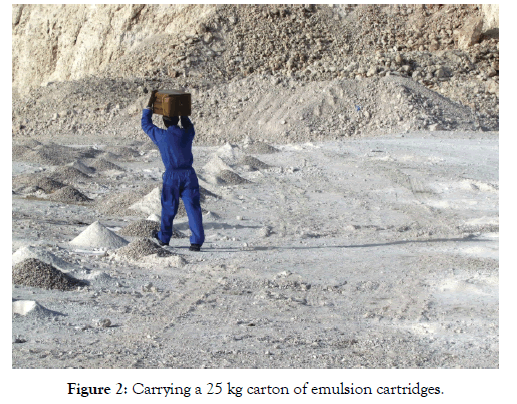
Figure 2: Carrying a 25 kg carton of emulsion cartridges.
• Distribution of ANFO bags to each hole alongside emulsion cartridges/boosters.
• Priming of holes using either 10 g/m detonating cord or Nonel detonators and emulsion cartridges or boosters.
• Manual charging of holes by pouring ANFO/decking.
• Stemming.
• Hooking up electric detonator leg wires.
• Checking the electrical resistance of the detonators.
• Follow clearing and security measures for blast area.
• Setting up and operating seismograph for blasting.
• Firing.
• Checking blast site after detonation of blast and signaling “all clear” if no case of misfire.
• Performs proper disposal of debris such as empty boxes, cartons and bags.
The dynamic nature of the quarrying environment exposed the blasting crew to a number of injury risk factors and various underlying attributes were observed to be the sources. A preliminary task analysis study revealed some concern in the following areas; manual distribution of explosives, priming, charging, decking, and stemming.
Weather
Yearly, from the month of June to September the coastal fringe of Dhofar experiences the Khareef season, a conversational Arabic term describing an exceptional weather pattern in the Arabian Gulf. The monsoon is caused by surface wind, which heartens an upwelling of waters in the Indian Ocean and, in turn, the cooling of the southern regions of Oman emanating from the moist air and rainwater created [5]. During this session, the mountains are covered in white fog. Uniquely at the quarry, the cloud (without thunder storm) moved periodically in the early hours as blasting activities took place forming a cloud ceiling which blurred vision, and partly moistened the ground. This misty atmosphere (Figure 1) made the quarry floor sticky when stepped upon, increasing the likelihood of ankle pain while in motion. Gripping of the detonating cord was also affected as it became a bit slippery. The Shammal winds (Qidwai, 1988) occasionally moving at speed exceeding 67 km/h picking up dust on its path often times was encountered during blasting [6]. Dust particles repeatedly settled on the outer eye of the blasting crew even though safety goggles were in use. The dust particles still penetrated due to its fineness and speed of movement. The strong wind also blew around any loose blasting accessory and debris that were not firmly secured. The high humidity and low cloud cover made noise level higher than normal, the air over pressure measurements averaging 148 dBL. By and large, the adverse weather posed the greatest cause of body discomfort as noticed in the Khareef and windy months (Figure 3A-3D).
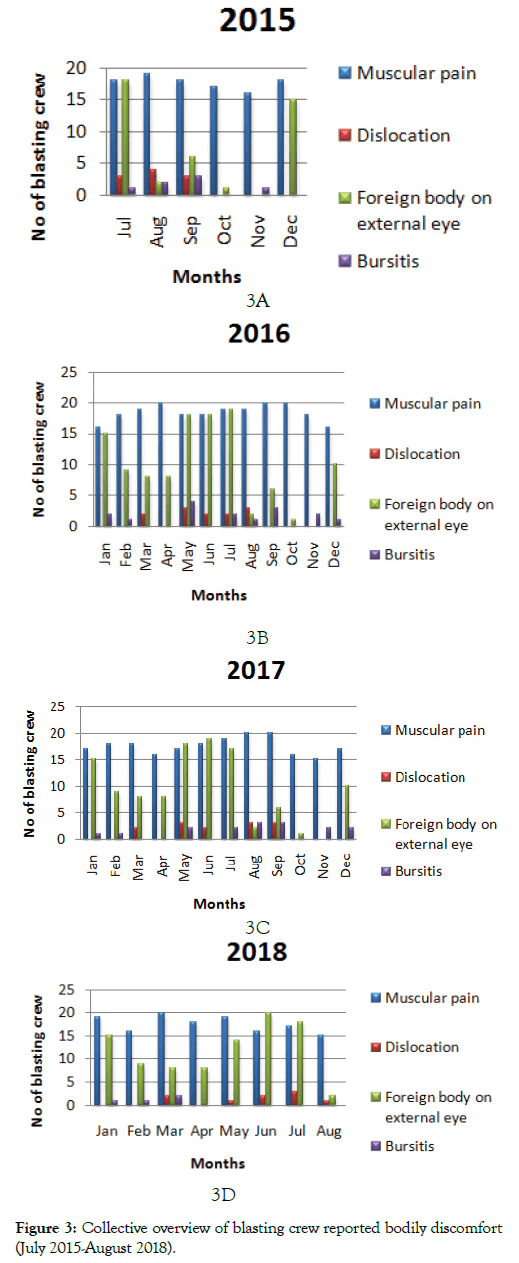
Figure 3: Collective overview of blasting crew reported bodily discomfort (July 2015-August 2018).
Ideally, blasting activities are to be avoided in inclement weather, when there are temperature inversions, very strong winds, and cyclonic storms. However, the remoteness of the quarry, lack of updated weather forecast for the mountainous areas and the unpredictable cloud movement/winds during blasting, coupled with the fact that the explosives magazine was about 95 km away from the quarry, made blasting cancellation difficult when already onsite. An exception though was during the ferocious cyclone Mekunu in May 2018, when the Royal Oman Police (ROP) cancelled all blasting activities within the Dhofar Governorate for a week.
Geology
The geology of the quarry made decking imperative as there were a lot of structural discontinuities such as joints, voids and cavities. Dick, et al suggested the filling of small voids with stemming material [7]. Avoiding them certainly improved fragmentation, reduced the amount of explosives, and encouraged proper confinement consequently eliminating the likelihood of post detonation toxic fumes.
The act of decking involved using the stemming material {crushed stones(10 mm)} to fill up a section of the blast hole which wasn’t charged, primarily to avoid the small voids or to aid in the reduction of the explosive column by providing the requisite confinement for blasting. This process entailed monitoring of the explosive column as charging took place as guided by the drillers log and then manually poured the material to the desired height. Majan Mining company policy prohibits the usage of shovels on site during blasting, so often the leg was used to push the decking material into the blast hole. Prolonged decking using this method created hip/ thigh/ankle pain (Table 1). Occasionally, an extra crew member was assigned to deck using an improvised plastic scrapper to push a measured quantity down the hole, this he did by crouching.
Table 1: Risk factors by observed tasks.
| Target Tasks | Primary Risk Factor |
|---|---|
| Distribution of Explosives | Lifting and carrying 25kg Anfo bags and emulsion boxes from the truck. Distribution of cartridges, Nonel, Boosters, and ANFO bags to blast holes on un-even, sloppy surface. Exposure to extreme weather conditions. |
| Priming | Twisting, holding, cutting/knotting detonating cord, bending. Exposure to extreme weather conditions. |
| Charging | Pouring of ANFO in bent or stooped postures. Exposure to extreme weather conditions. |
| Decking | Awkward body posture using the legs, twisting of ankle, crouching to pour aggregate. Exposure to extreme weather conditions. |
| Stemming | Bending, holding and forceful pushing engaging the hands, shoulder and twisting the back. Exposure to extreme weather conditions. |
| Hook up | Repetitive extended forward reach (stooping) to surface trunk line and lead wire. Exposure to extreme weather conditions. |
Furthermore, when developing the top benches, at the new quarry (Q2), the sloppy conical hills posed a lot of danger and were cumbersome to travers with cartons of emulsion or bags of ANFO each weighing 25 kg for distribution to every blast hole. Awkward posturing and bending against gradient to prime, charge, and stem brought much muscular pain (mostly on the back and shoulders) and discomfort to the crew (Figure 4). In this scenario, upon evaluation of the survey responses from the crew, task rotation was introduced to mitigate the continuous exposure to a particular risk factor by the helpers who always bore the brunt.
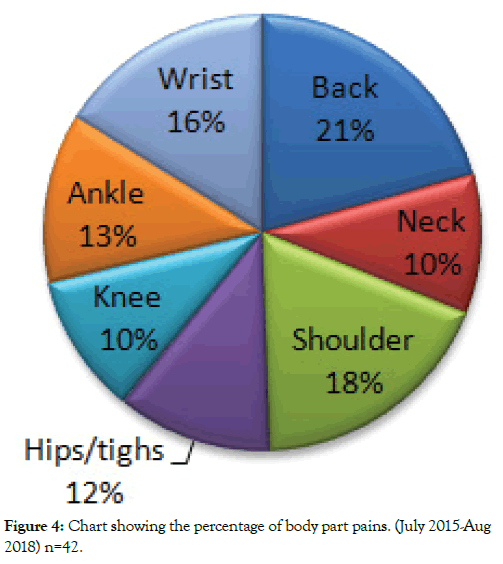
Figure 4: Chart showing the percentage of body part pains. (July 2015-Aug 2018) n=42.
Blast design
Good blasting techniques have direct benefit on quarrying operations because well designed blasts reduce risks associated with environmental, health and safety concerns and improve operations through efficient extraction and environmental management. At Majan Mining, most often, detonating cord was used (Figure 5), though Nonel detonators were also used when blasting very close to sensitive structures. Various blast designs were used at the cause of the study, the variance centred on the delay pattern. When using the detonating cord, the Shot Delay Detonator (SDD) i.e. electric detonator, cord relay and Nonel connectors were used at various times, whereas Nonel connectors were used with Nonel detonators. While using the SDD, multiple numbers were involved, and it necessitated taping them at specific rows and blocks, directionally.
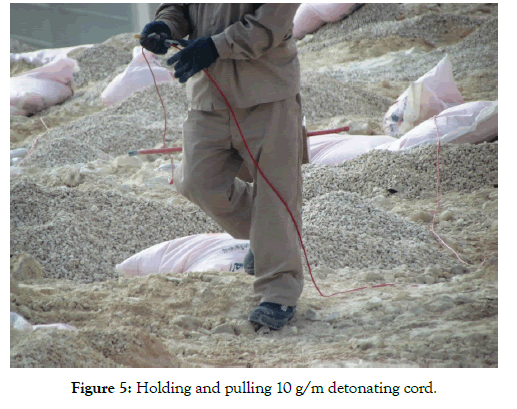
Figure 5: Holding and pulling 10 g/m detonating cord.
The electrical resistance of each was measured to make sure of its continuity (Figure 6). This blast design involved a lot of squatting, tapping, and measuring. It was observed that the frequency of back, thigh, and shoulder pain increased within the period (Table 2). However, as the design changed to cord relays, with less squatting, there was a significant improvement with less pain. Further modification of the blast design is advised so as to eliminate the risk factors associated with rolling out lengthy lead wire related to shock tube blasting systems. Kinks in the cable are constantly straightened to avoid internal breaks, while dragging along the ground is never advised; this is to forestall possible damage to the insulation. This final preparation procedure for firing necessitates extra care and periodic testing for continuity at every joint, these being potential sources for current leakage. Okeke recommended the usage of the Electronic Blasting System (EBS), with its benefit of firing remotely and wirelessly [8]. It also has an ergonomic advantage of eliminating the rolling out of excess wires to the firing point.
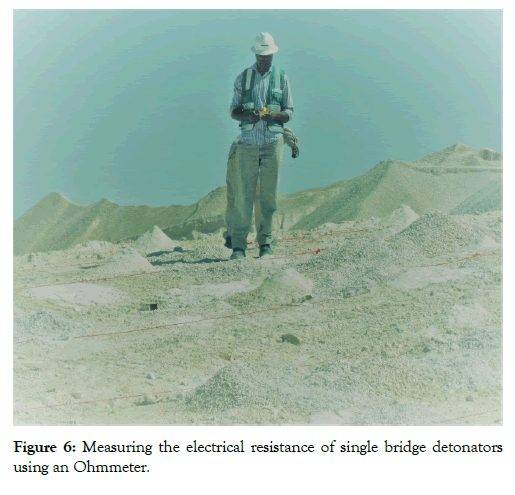
Figure 6: Measuring the electrical resistance of single bridge detonators using an Ohmmeter.
Table 2: Ratings of body part discomfort by various personnel.
| Personnel | Body parts | Task |
|---|---|---|
| Engineer | Back, ankles, hands. | Hook up, Checking electrical resistance of the detonator, Setting up the seismograph, Firing. |
| Foreman | Back, ankles, hands, elbow, shoulder. | Priming, Checking the deck height and stemming length. |
| Helper | Back, ankles, hands, elbow, shoulder, hips/thighs, knees, head and neck. | Lifting, Carrying, Priming, Charging, Decking, Stemming, rolling out lead wire, disposal of empty cartons, boxes and bags. |
Effects of ergonomic discomfort
Bodily discomfort can make experienced and highly skilled personnel to erroneously perform some tasks on site. Flyrocks, toe formation, extended sleep-time and misfire were some mistakes that could be attributable to this.
Sticky safety boots picking up mud, and becoming damp due to moisture made walking uncomfortable and sluggish. This inevitably slowed down mobility around the blasting area and unnecessarily increased the sleep-time. Incidents of ankle sprain, and dislocation on the other hand led to Lost Time Injuries (LTI) (Table 3).
Table 3: Incident report per year.
| Incident data | ||||
|---|---|---|---|---|
| 2015 | 2016 | 2017 | 2018 | |
| Fatalities | 0 | 0 | 0 | 0 |
| Number of Lost Time Injuries | 4 | 3 | 1 | 0 |
| Number of Medical Treatment Injuries | 0 | 0 | 0 | 0 |
| Number of First Aid cases | 6 | 4 | 2 | 0 |
| Total Man-hours | 144 | 380 | 376 | 240 |
Research has shown that excessive sleep time contributes to the formation of post detonating toxic fumes DEDDI, 2011, over exposure to which could lead to undesirable medical conditions [9].
Usage of table knife to cut the detonating cord which could be either too sharp or blunt, the handle of which wasn’t well designed for such cutting, exposed the user to hazardous shearing action. Skin cutting necessitated first aid treatment. Specialized cutter should be used instead (Table 4). A plaster or bandage bearing finger in pain will not allow for an efficient priming or charging process.
Table 4: Some ergonomic interventions and recommendations.
| Task | Concern | Proffered solution | Recommendation |
|---|---|---|---|
| Priming | Body cut, when using a sharp knife to cut the detonating cord. | Safety gloves with dotted surface to enhance gripping of the knife handle. | Introduce specially designed detonating cord cutters with ergonomically designed synthetic anvil for easy and comfortable gripping. |
| Decking | Body pain(Back, hip, thigh, ankle) from repetitive crouching | Plastic scrappers were used to push down crushed rock | Usage of blast bags such as AERO BlastBag™ for decking will certainly reduce the frequency of squatting down to pour crushed stones or aggregates. |
| Firing | Rolling out of excess lead wire | Electronic blasting system should be introduced. Apart from ergonomically eliminating the excess wire roll-out, remote blasting will give a safer blast radius in the blast exclusion zone. |
The unfavourable windy or misty environment with its attendant bodily discomfort made hitherto simple tasks such as priming and stemming to become a bit difficult. Poor priming produced toes on the bench floor; while inadequate stemming created flyrocks. Loading an explosive charge close to the collar zone in a blast hole will cause insufficient stemming resulting in bench-top flyrock. In as much as the quarries were well situated afar off from building structures, flyrocks could cause the damage of the surface trunk line leading to a cut-off. This development will in turn translate to spending more time than planned for blasting activities, consequently affecting other downstream activities at the crusher, as the excavators and haul trucks must remain idle until the “all clear signal” is given. Toe formation on the other hand entails extra cost as a rock breaker will be assigned to loosen it.
It is pertinent to note however that not all misfire, toe formation or flyrock incidents possibly will be attributed to ergonomic discomfort. Other salient reasons abound, which is beyond the scope of this paper.
Contouring presented the greatest risks for the entire blasting crew while conducting blasting activities during development in the new quarry. This involved the crew physically walking slopes of up to 25° on an uneven ground with uncertain footing to prime, load, sometimes deck, and then stem the blast holes. Often, cartons of emulsion cartridges, cast boosters, detonators, detonating cord and ANFO bags had to be manually carried along the rugged terrain. These manual-handling risks linked with the blasting activity were massive and this task was chiefly among those with the highest potential for injury on site.
Bodily discomfort normally disorientates ones way of reasoning leading to mistakes and the inability to efficiently complete a task. Blasting, being a laborious activity must be perfectly done so as to achieve the desired end result at a safe and cost effective manner. Appropriate Personal Protective Equipment (PPE) specifically designed for inclement weather and for various tasks alongside job rotation; a change in routine and the adoption of an ergonomic process will help achieve these desired goals in a quarry on such an altitude.
Citation: Okeke RR (2020) Ergonomic Appraisal of Blasting Activities at Majan Limestone Quarry 9:260. doi: 10.35248/2165-7556.20.10.260
Received: 26-Feb-2020 Accepted: 02-Apr-2020 Published: 09-Apr-2020 , DOI: 10.35248/2165-7556.20.10.260
Copyright: © Okeke RR. This is an open-access article distributed under the terms of the Creative Commons Attribution License, which permits unrestricted use, distribution, and reproduction in any medium, provided the original author and source are credited.